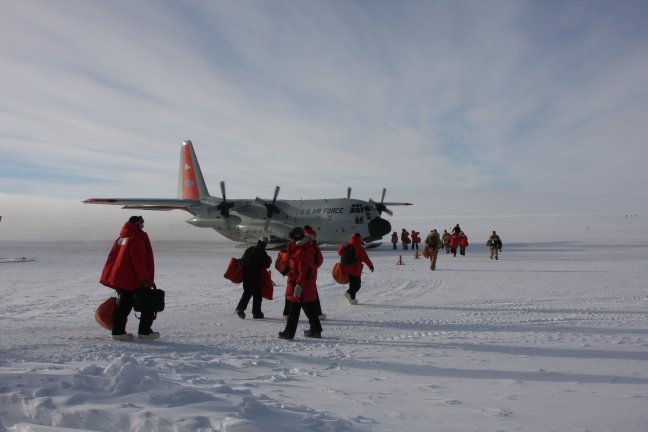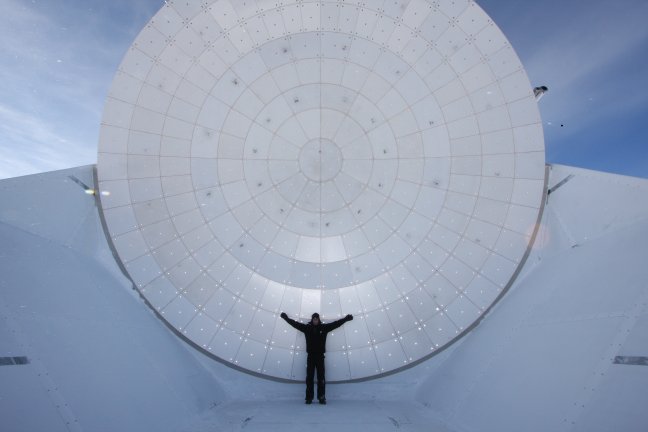February,
2008....J.
Dana Hrubes...updated February 29, 2008 , 0002 GMT
(CLICK ON UNDERLINED
LINKS FOR
PHOTOS....CLICK
"BACK" ON YOUR BROWSER TO RETURN TO THIS PAGE)


The remainder of the summer people board the last LC-130 aircraft
for the season leaving winter polies isolated for 8-1/2 months
(photo by keith vanderlinde)
February is a month of transition for winterovers. It is an exciting time as the last of the
summer people board the aircraft for the final flight from Pole for
8-1/2 months, leaving us in total isolation. (2 photos by Keith Vanderlinde) last plane rotating last plane waving goodbye for 8-1/2 months No
matter how many times I have wintered, the beginning of the 8-1/2
months of winter still gives me the same strange feeling I got the
first time.
In one of the last flights was the arff, the aircraft rescue and
firefighting vehicle. It was shipped back to McMurdo station for the
long winter, since we don't need it and it will be too cold to operate
it anyway. arff and firefighter arff
Immediately after the last plane left on February 14th, winter
preparations began. We have to prepare the station for the long dark
winter. We pulled up fuel lines that were used to fuel the station for
winter, we removed all the aircraft skiway flags (that's about 6 miles
worth), we installed flaglines to all of the off-station science buildings
that are visited every day, each of us stored away caches of extreme
cold weather (ECW) clothing off-site in case of a devastating fire, we man-hauled
tons of food and cargo up to the elevated station, and we all moved into
our winter rooms. I'm augering hard ice for flags (4 photos by steffen richter) augering ice installing flag I'm returning with fresh battery for auger steff installing a flag
I am setting up my winter room. I got a good one because of my South
Pole ice time to date... over 3 years and 6 months.. I have
several computers and an iridium pager so I can monitor and control the
telescope from my room and be paged if selected parameters go out of
range, meaning I would have to put on my ECW and walk the mile to the telescope any time of the day an
emergency occurs. If you look at my website from 2001 and 2004 you can
tell that the living conditions have improved significantly from the old days in the dome, although I miss living there. After
many years of living in darkness, I have optimized my selection of
mini-lights for my room and I have decided that purple and orange are
optimum for maximum cheeriness and well being. room-1 room-2 I also have a nice office to perform my station science leader duties. station science leader office office with a view of the geographic south pole
I also have another nice office and a building with
workshops to work in
at the Dark Sector Laboratory(DSL), where I work with Keith,
overlooking South Pole Telescope (SPT), our large 10 meter microwave
telescope. DSL/SPT is a mile from the main station. DSL-SPT-office

I am standing on the ground shield in front of the 10 m (33 ft) primary
microwave mirror
February was also a big month for the South Pole Telescope. In the last
several weeks before station closing, the Berkeley and Chicago teams
worked around the clock to warm up the secondary and receiver cryostat,
open up the receiver and replace some of the bolometer (sensor) wedges
in the hope to increase the sensitivity and signal to noise ratio of
the already much improved sensor array. It was a risky venture, given
the time left before station closing, but it was accomplished and the
results are very good.
We are now ready to start the observing season
armed with the best Cosmic Microwave Background (CMB) detector ever. It was tight getting the
receiver back together, mating it with the secondary cryostat, pumping
the whole subsystem down to about 1 x 10-7 Torr and then cooling it
down in time to test it before February 14th, the closing date of the station. The cooldown process
takes almost 5 days and the result is a sensor array that is cooled
down to 0.26 Kelvin, just 1/4 of a degree Celsius above absolute zero.
This low temperature is necessary to detect the very weak low
temperature 150 GHz microwave signal at a respectable signal to noise
ratio. After the cryostat and receiver was assembled, most of the team
was needed to perform the arduous task of lifting, securing and
connecting hundreds of cables to this 3000 lb mass. telescope showing the heated receiver cabin another view of telescope showing cabin for receiver I'm installing a new pulse tube cooler into the receiver cryostat with brad, the cryostat designer preparing to lift receiver and secondary mirror cryostat into cabin preparing to lift(you can see the microwave window in the roof of the cabin) begin cryostat lift team up in cabin ready to receive cryostats lifting cryostat-1 lifting cryosat-2 lifting cryostat-3 mounting cryostat to optical bench connecting pulse tube cooler helium lines
Finally, the South Pole Telescope (SPT) was tested and one of the first
images taken to confirm its operation was to get an image of a well
known galaxy cluster, AS1063. The detection and mapping of galaxy
clusters using the Sunyaev-Zel'dovich effect (SZE) is
the main goal of SPT for the next two years. Once discovered and mapped, these galaxy clusters can
then be viewed with optical telescopes to determine red shifting and
thus distances and age of these massive entities.
coming soon
A preliminary CMB-SZE image map of
galaxy cluster AS1063 taken with SPT
For
the first two weeks of winter since the summer team has left, Keith and
I have been tweaking parameters on the refrigeration cycle. The
bolometer array (sensor) is cooled down to about 0.25 degrees above
absolute zero (0.25 Kelvin) using as series of helium coolers. A
pulse tube cooler takes us down to about 2.7 Kelvin and then a
subsequent Simon Chase helium 10 cooler
allows us to take the bolometers and SQUIDs down to
transition and superconducting temperatures as low as 1/4 degree
Kelvin. The entire
cooling system is closed cycle and requires no transfer of expendable
cryogens. The Simon Chase cooler is called a helium 10 cooler because
the three stages, a helium 4 stage and two helium 3 stages adds up to
10. Helium 3, with an atomic mass af about 3 is an isotope of
standard helium 4 and its properties allow us to get to lower
temperatures. We have been tweaking the refrigeration cycle in order to
optimize the cycle time. During observation time, liquid helium 3
eventually all vaporizes and is collected in the
charcoal adsorption devices. The helium is then recondensed as liquid
by recycling (heating) the charcoal and driving off the helium,
allowing it to condense at the the other end of the cooling stage. Minimizing the re-cycle time and maximizing the helium 3
vaporization time at 0.25 Kelvin before running out of liquid helium 3
results in the
maximum CMB observation time. We are getting total cycle times on the order of 39 hours,
although we would like to push it to 48 hours, in order to make the
winterover's sleep cycle a bit more normal.
In addition, we have been running focus scans schedules sent to us in
order to optimize the optical bench positions as a function of
telescope orientation. The University of Chicago, Berkeley, Case
Western Reserve and the other collaborators are working hard to send us
focus scans, CMB scans and to troubleshoot every aspect of this complex
instrument. Keith and I participate in two teleconferences per week with
the entire team (http://pole.uchicago.edu/) using the
Iridium satellite system.
We have also had numerous mechanical issues to deal with which is
typical in this harsh climate. It is still February and the temperature
has already dropped to -67 F (-55C) and it will continue to drop over
the next months to temperatures that can exceed -110 F(-80C) and that
is the static temperature, not any wind chill nonsense. Just this
week, the 2000 lb optical bench failed to move to the correct position
during a focus scan. The optical bench has 6 actuators driven by 6
servo motors and gear trains. One of the six actuators ceased moving,
so Keith and I quickly aborted the current focus scan, docked the
telescope and crawled up into the receiver cabin using the hydraulic
man-lift. After 7 hours of troubleshooting and repair in this extremely
tight space we fixed the actuator and got the telescope back in
operation. The telescope was brought down by a 1/4-inch set screw that
had loosened. one of the six servo motors and optical bench actuators removing the servo motor measuring the precise depth for the coupling checking out the coupling repair closing the 5000 lb roof after undocking the telescope Other mechanical tasks included replacement of the rollers on the 5000lb rolling docking roof. finishing replacement on the roof
The mechanical aspects of the telescope are a diversion from the operation of the telescope with its many computers. sweeping snow out of the primary mirror ground shield
Some parting shots of SPT while the sun is still up. SPT-1 SPT-2 SPT-3 many summer days are grey
March: the sun sets and will not return for 6 months!
A Real-Time Photo of South Pole Station as Seen
from the ARO
Building (live when satellite is up)
A
Comprehensive
South Pole Web Site by Bill Spindler
Winterover
Web
Pages
(Bill Spindler's List)
MY
SOUTH
POLE 2007 HOME PAGE
MY BI-POLAR HOME PAGE
